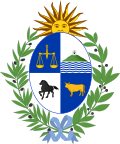This article needs additional citations for verification .(November 2025) |


| This article is part of a series on the |
| Culture of Uruguay |
|---|
 |
| Uruguay Portal |
You can help expand this article with text translated from the corresponding article in Spanish. (February 2025)Click [show] for important translation instructions.
|
The National Cockade of Uruguay was first adopted by law on December 22, 1828. It features the colours of the national flag, blue and white. [1]